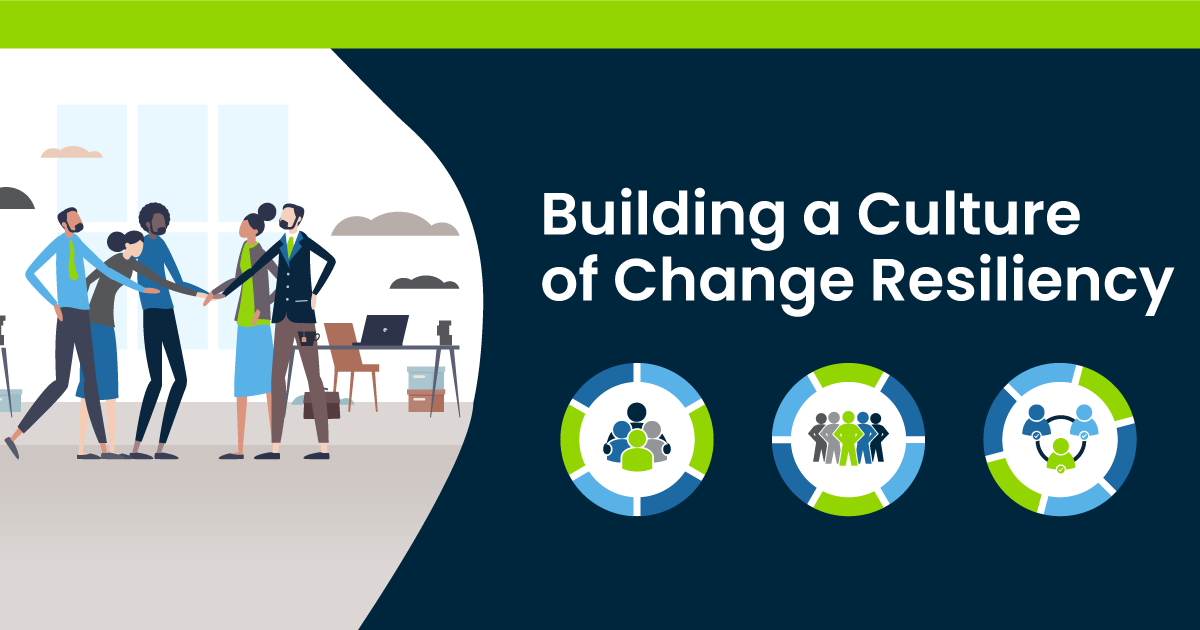
Building a Culture of Change Resiliency
Highlights
-
According to McKinsey & Company, 84% of CEOs believe innovation is critical to growth, but only 6% are satisfied with their innovation performance.
-
Creating a culture that allows for experimentation and failure is critical to fostering innovation, resiliency and growth.
Business leaders know they can’t tread water. If they want to succeed tomorrow, they need to innovate today. But many times, there is a disconnect that prevents leaders from achieving true innovation.
According to McKinsey & Company1, 84% of CEOs believe innovation is critical to growth, but only 6% are satisfied with their innovation performance.
It’s human nature to resist change. That’s why change management is critical. However, even when you embrace change, things don’t always go smoothly.
“When change initiatives fail (and they do so more often than not), they rarely fail on technical skills (hard skills), they fail on the people skills,” says David A. Shore, instructor of two Harvard Professional Development2 programs.
Progress Is Rarely a Straight Line
The road to transformation is always paved with a few unexpected detours. You can establish goals and make plans to achieve them, but unfortunately, you can’t predict the future or anticipate every external influence.
The COVID-19 pandemic made this all too clear. In 2019, many businesses were making plans for 2020, but none of those plans accounted for a global pandemic. Some businesses couldn’t survive. Meanwhile, other businesses thrived – quickly adapting their processes and updating their products and services to succeed in their new environment.
Why do some companies thrive in the face of change while others fail? The answer can be found in each company’s level of change resiliency.
What Is Change Resiliency?
McKinsey & Company3 says resilient organizations don’t just bounce back from challenges – they bounce forward. They found that companies with strong financial performance during the pandemic shared resilient behaviors such as knowledge sharing, performance reviews and bottom-up innovation.
Every organization experiences setbacks, but resilient organizations know how to use those experiences to succeed. This is especially crucial when undergoing change. Without change resiliency, normal setbacks can cause innovation to grind to a halt. Your company may even end up further behind than where it started. With change resiliency, you can use setbacks to learn and grow.
How do you build change resiliency? Here are three essential steps.
1. Enable an Innovation Culture
Many people are resistant to change, but there are also people who are eager to innovate. These are the people who can lead your company through periods of transformation. Per Denise Garth, chief strategy officer at Majesco, “Innovative change agents often think outside the box, leveraging knowledge and experiences from a wide variety of areas – from different jobs, roles and industries to reimagine the possibilities.” 4 These change agents need to be embraced by organizations.
At Connected Claims USA 2022, Steve Donnelly, Chief Claims Officer at Amerisure recommended to carriers that they: “Build a culture where it’s okay to fail; where the focus is put on the lesson as opposed to the failure. Those principles of learning and adapting get and keep people engaged.” 5 Creating a culture that allows for experimentation and failure is critical to fostering innovation, resiliency and growth.
2. Prioritize Consistency and Rigor
Achieving real change also requires a comprehensive strategy that can be clearly and consistently communicated and executed. At Connected Claims USA, Stephanie Behnke, Senior Solutions Consultant at Hi Marley, and Patrick Nails, EVP & Chief Claims Officer at Arch Insurance discussed the importance of having change management rigor and its impact on transformation success. Having separate change management project plans helps to develop ‘change muscle’ that reduces anxiety and promotes resilience, explained Behnke. Noting that the speed of change has only increased the amount of transformation initiatives and resultant organizational change fatigue, Nails concurred with Behnke, reiterating the importance of having a consistent change management approach that promotes both skill and confidence.6
3. Focus on People
Technology is an important part of innovation, but it’s only part of the equation. According to Shore2, “If you can’t change your people, you can’t change anything.” It’s critical to get your people on board and keep morale high. Celebrate progress and small wins, and recognize the contribution of the individuals at your company.
Business leaders also need to make sure their employees are taken care of. During the COVID-19 pandemic, businesses weren’t the only ones facing unexpected challenges. Working parents suddenly had to find a way to oversee their children’s education while they worked. At the same time, people were worried about their health and their loved ones. Some companies stepped up and provided new mental health benefits and flexible schedules.
As far as the ones that didn’t? There’s a reason the pandemic was followed by the Great Resignation and the Quiet Quitting trend. If you don’t take care of your team and help your employees navigate change, you could lose some of your best workers along the way.
Build A Strong Ecosystem
One more tip: progress doesn’t happen in a vacuum – it comes from collaboration. True innovators learn from others. They find the resources and build an ecosystem to support their transformation. If you’re building an ecosystem, you can count on One Inc to provide digital payment tools and expertise. Our Client Success Team actively partners with clients to optimize their payment transformation by providing education, digital adoption best practices, digital payment data and metrics, and best-in-class benchmarking. With One Inc at your side, continually adding value, digital transformation success is achievable.
Sources:
- https://www.mckinsey.com/capabilities/strategy-and-corporate-finance/how-we-help-clients/growth-and-innovation
- https://professional.dce.harvard.edu/blog/7-reasons-why-change-management-strategies-fail-and-how-to-avoid-them/
- https://www.mckinsey.com/capabilities/people-and-organizational-performance/our-insights/raising-the-resilience-of-your-organization
- https://www.insurancethoughtleadership.com/going-digital/characteristics-effective-change-agent.
- Connected Claims USA 2022, Reuters Events.
- Connected Claims USA 2022, Reuters Events.
Tags: Technology & Innovation, Business

Written by The One Inc Content Team
The One Inc Content Team strives to provide valuable insights about digital trends and payments innovation for the insurance community.
Want to read more articles like this?

